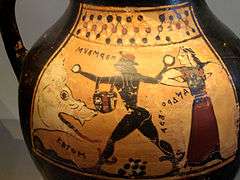Cetus (mythology)

In Ancient Greek, the word kētos (κῆτος, plural kētē or kētea, κήτη or κήτεα)—Latinized as cetus (pl. cetea)—denotes a large fish, a whale, a shark, or a sea monster.[1] The sea monsters slain by Perseus and Heracles were each referred to as a cetus by ancient sources.[2] The term cetacean (for whale) originates from cetus. In Greek art, cetea were depicted as serpentine fish. The name of the mythological figure Ceto is derived from ketos. The name of the constellation Cetus also derives from this word.
Mythology
Queen Cassiopeia boasted that she and her daughter Andromeda were more beautiful than the Nereids, which invoked the wrath of Poseidon who sent the sea monster Cetus to attack Æthiopia. Upon consulting a wise oracle, King Cepheus and Queen Cassiopeia were told to sacrifice Andromeda to Cetus. They had Andromeda chained to a rock near the ocean so that Cetus could devour her. After finding Andromeda chained to the rock and learning of her plight, Perseus managed to slay Cetus when the creature emerged from the ocean to devour her. In one version, Perseus drove his sword into Cetus's back. In another version, Perseus used Medusa's head to turn Cetus to stone.
Depictions
The Cetus is commonly depicted as fish-like and serpentine with a long muzzle. Alternate depictions may include long ears, horns, legs, flippers, tentacles and/or a fluke-like tail. It is often depicted fighting Perseus or as the mount of a Nereid.[3]
In the Bible
In Jonah 2:1 (1:17 in English translation), the Hebrew text reads dag gadol (דג גדול), which literally means "great fish". The Septuagint translates this phrase into Greek as mega ketos (μέγα κῆτος). The term ketos alone means "huge fish", and in Greek mythology the term was closely associated with sea monsters. Jerome later translated this phrase as piscis grandis in his Latin Vulgate. However, he translated the Greek word kētos as cetus in Gospel of Matthew 12:40: "For as Jonah was three days and three nights in the belly of a huge fish, so the Son of Man will be three days and three nights in the heart of the earth."[4]
Ships and sailing
Cetus is commonly used as a ship's name or figurehead denoting either a ship unafraid of the sea or a ruthless pirate ship to be feared. Cetus (and its translations) are also viewed as misfortune or bad omen by sailors. Superstitious sailors believed in a cetus as the bringer of a great storm or misfortune on the ship. They associated it with lost cargo, the presence of pirates, or being swept off course, and avoided any talk of it aboard ship.
In other cultures
Some scholars theorize that images of the Ketos in Central Asia influenced depictions of the Chinese Dragon and Indian makara. They suggest that after contact with silk-road images of the Ketos, the Chinese dragon appeared more reptilian and shifted head-shape.[5]
In popular culture
In the 1981 fantasy film Clash of the Titans and its 2010 remake, the role of Cetus is filled by a tentacled, roughly humanoid Kraken. In both versions, Perseus uses the head of Medusa to turn it to stone.
In the 2003 animated film Sinbad: Legend of the Seven Seas, Cetus appears as a massive squid-like sea monster sent by the goddess Eris to attack the protagonist and his best friend.
See also
Notes
- ↑ "κῆτος" in Liddell, Henry and Robert Scott. 19406. A Greek-English Lexicon. Revised by H.S. Jones and R. McKenzie.. Oxford: Clarendon Press.
- ↑ Perseus: Apollodorus 2.4.3. Heracles: Homer Iliad 21.441, Apollodorus 2.5.9.
- ↑ Boardman, John (2015). The Greeks in Asia. Thames and Hudson. ISBN 0500252130.
- ↑ http://www.biblegateway.com/passage/?search=Matthew+12%3A40&version=NIV
- ↑ Boardman, John (2015). The Greeks in Asia. Thames and Hudson. ISBN 0500252130.